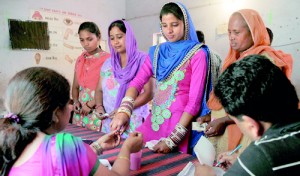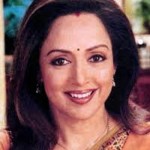Sunday Times 2
An election without end: Why it takes so long in India
As India heads towards the eighth phase of its marathon general election on Wednesday, many are asking whether the world’s largest democracy deserves such a protracted voting exercise.

An Indian polling officer marks the finger of a newly married woman (C) prior to voting in the Lok Sabha elections at a polling booth in the village Pandori, on the outskirts of Amritsar on April 30, 2014. India's 814-million-strong electorate is voting in the world's biggest election which is set to sweep the Hindu nationalist opposition to power at a time of low growth, anger about corruption and warnings about religious unrest. AFP
For those not up to speed, India’s 16th general election for its 543 parliamentary seats is currently being held in nine phases from 7 April to 12 May — at 36 days, it is the longest in the country’s history.
The five-phase 2009 vote took about a month — this time there are almost double the stages but the process will not take that much longer. The higher number of phases is explained mainly by polling in 18 seats in smaller north-eastern states being staggered across three voting days because of “administrative reasons”.
This is “an election without end” laments political analyst Jawid Laiq. India’s drawn-out election, he argues, leads to several unintended consequences: campaigns become bitter and acrimonious and development work is on hold because of a model code of conduct for candidates and political parties. If vast and populous countries like Indonesia and Brazil can complete their elections in a single day, he asks, why can’t India with its formidable election machinery?
It wasn’t always like this. India’s historic first election in 1951-52 took three months to complete. Between 1962 and 1989, general elections were completed in between four and 10 days. The four-day elections in 1980 were the country’s shortest ever.
‘Partisan’ police
But most of these polls were marked by violence and were hardly free and fair. Scores of people lost their lives in clashes — and ballot stuffing and intimidation of voters was common. The local police failed to keep order and were often accused of taking sides under pressure from ruling politicians. In the 1990s, under a tough new election chief, T.N. Seshan, things began to change. Mr. Seshan sought paramilitary forces from the federal government to keep violence in check during an election. Later the Supreme Court also asked the Government to ensure the availability of security forces during elections.
“The long-drawn, multi-phased election in India boils down to a single reason — security,” former election commissioner SY Qureshi tells me. “The local police are seen to be partisan; so we need to deploy federal forces. These forces have been freed up from their duties and moved all around the country to ensure peace. That is why it takes time.”
Some 120,000 such federal troops have been deployed this time — they are drawn from security forces who guard borders, industrial installations and railway properties, among other things.
In what is truly a daunting logistical exercise, these troops have to be moved about in trains and buses all over the country to ensure security for voters, polling stations, counting centres and strong rooms where the electronic voting machines are stored. “The integrity of elections is paramount. Since we’ve had phased elections, they have definitely become freer and fairer,” says Mr Qureshi.
Voting behaviour
But don’t long, staggered polls have an impact on voting behaviour, thanks to informal exit polls, social media chatter and whisper campaigns for or against parties?
Political scientist Sanjay Kumar of the Delhi-based Centre for the Study of Developing Societies says there is no evidence to prove this necessarily happens. He reckons that a staggered poll could possibly add to the victory margin of a party which is riding a wave of support and widely expected to win by a large margin.
But in a close contest, a phased election can hardly influence the final results because the voters “don’t know who’s going to win anyway”. Ergo, a staggered election cannot influence the final results.
Many also believe phased elections put parties and candidates whose fates are decided in the early stages at a disadvantage over others who get more time to campaign.
But then parties and candidates who are contesting later rounds also have to spend more money and energy running a longer campaign in India’s scorching summer heat. So a longer campaign possibly favours nobody.
India’s marathon election actually shines a light on one of its most glaring deficiencies: its poorly paid, badly equipped, ill-trained and understaffed police. Unless the police force is beefed up considerably and its standard improves, voters will have to live with “elections without end”.
Courtesy BBC
| What’s in a name? Dummy candidates confuse voters
NEW DELHI, May 03 (AFP) – Indian politician Chandulal Sahu, standing for the second time for a seat in parliament, was irritated but not surprised when he saw he was running against seven competitors who share his name. Popular Bollywood actor Hema Malini, contesting in the holy city of Mathura, is up against two other Hema Malinis while veteran politician Amarinder Singh faces a similarly confusing challenge in northern Punjab.  Actress turned politician Hema Malini challenged by two other Hema Malinis Even Narendra Modi, the election frontrunner for the opposition Bharatiya Janata Party (BJP), briefly faced a threat from a namesake in his constituency in the western state of Gujarat. Far from a coincidence, these “dummy” candidates are an age-old trick in Indian politics designed to fool voters who might mistakenly select the wrong person once inside the polling booth. The tactic might have reached its high-water mark in Sahu’s constituency in central Chhattisgarh state, which voted last Thursday during India’s huge multi-phased general elections. “What can one do? It’s a conspiracy by my rivals. But such gimmicks won’t work,” Sahu told AFP. “Voters in my area are aware and I am confident they will vote for the right Sahu.” Political parties often scout for namesakes and then fund their election expenses in order to pit them against rivals in constituencies where a few hundred votes could swing the result. The unknown candidate is given his or her party symbol, which is usually designed to look like the one used by the more famous rival. Ashutosh, a former TV anchor who uses one name, is a leader of the rookie Aam Aadmi (Common Man) Party whose symbol is a broom. “Voters are bound to get confused because of two Ashustoshes,” an Aam Aadmi Party spokeswoman told AFP. Delhi’s additional chief electoral officer Neeraj Bharati said the onus lay with the real candidates to expose the fakes. “We put up a list of all contesting candidates next to their symbols outside every polling booth for awareness,” he said. “But it really boils down to the real candidates. They must do good propaganda and expose the proxy candidate,” he added. Vinod Kapri, editor-in-chief of News Express TV network which recently exposed how dummies were set up, explained why it was worth investing time and money in the underhand tactics. “Even if the dummy manages to eat a little bit into the share of his namesake, the job is done as the victory margins are often narrow,” he explained. “If you give him big money, he will do anything for you.” The elections, the world’s biggest, end on May 16 when results will be published. Modi faced a challenge in his Gujarat constituency of Vadodara from another Narendra Modi who is a member of the Congress party. The unknown candidate pulled out fearing reprisals.
|

